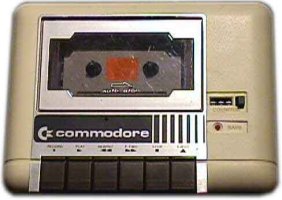Table of Contents
INTERFACING TO COMMODORE 8-BITS
X1541 Cable (aka XE1541, XM1541)
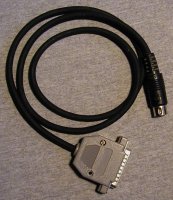 http://sta.c64.org/xcables.html
http://sta.c64.org/xcables.html
Components:
- Commodore IEC 6-pin DIN Connector
- Six conductor shielded cable
- DB25 Male Connector (& Hood)
- Four Diodes
This popular cable has two different purposes, initially it was designed for an IBM compatible PC w/parallel port to directly connect to a 1541 or other Commodore Disk Drive to read/write disk data (the most popular program to transfer commodore files is called Star Commander). Now it is also used to connect a Commodore 64 to an IBM compatible PC and with the 64 HDD program the PC will act as if it were a disk drive to the Commodore 64, either to run the images or to transfer files.
Some emulators also can use this cable to attach a disk drive to the (emulated) computer to enable compatibility of disk-based copy protected software.
NOTE: Make sure to use the right cable for your computer's hardware, the original X1541 cable can prove damaging to modern PC parallel ports. And Linux operating systems are limited to the XM1541 cable configuration.
PRLINK CABLE
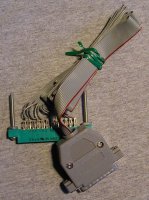 http://www.zimmers.net/anonftp/pub/cbm/crossplatform/transfer/CBM-to-PC/index.html
http://www.zimmers.net/anonftp/pub/cbm/crossplatform/transfer/CBM-to-PC/index.html
Components:
- 12/24 Edgercard Connetor .156“ connector spacing.
- 11 conductor ribbon cable
- DB25 Male Connector (& Hood)
Another way to connect Commodores to PCs in order to transfer data from the PC parallel printer port to the Commodore parallel user port. Unlike the X1541 the prlink can also work with the PET/CBM and B128 line of computers as this method employs the use of the parallel data port, though you need to have a working 8-bit computer and drive to get the data to the PC using this method.
This transfer method has been replaced by the more advanced and easier to use C2N232 interface and CBMLink software.
C2N232 INTERFACE
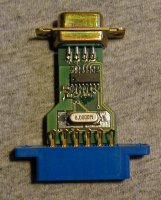 http://www.zimmers.net/anonftp/pub/cbm/crossplatform/transfer/C2N232/
http://www.zimmers.net/anonftp/pub/cbm/crossplatform/transfer/C2N232/
Components:
- C2N232 Interface
- Serial Extender cable
The C2N232, by Marko Makela of Finland is the successor to the prLink cable - with this datasette port adapter and UNIX/Windows software, using the cassette port the C2N232 increases the number of compatible computers to PET/CBM, B-128, VIC-20, Commodore 64/128 and now also the Plus/4 and C-16.
Another benefit is that since it uses a drive port of the Commodore, the PC can supply the necessary Commodore software via the cable - where in the prLink or SIPOD the operator had to either convert the boot loader or type in and run a program for the 8-bit side initially to start the connection, with the C2N-232 you press shift-run/stop on on the Commodore side and tell the client to upload the proper server software on the PC side. (with the exception of the B128 series which has no internal cassette handling routines).
Unlike many of the popular cables and adapters the C2N-232 is much more complex requiring a circuit card on which to place a micro controller and also program the firmware with the proper software. The C2N232 contains 128 bytes of RAM and 1024 sixteen-bit words of program memory and features 38400 bps full-duplex RS-232 with XON/XOFF and CTS/RTS handshaking and a 124-byte input buffer
The CBMlink software is also backwards compatible with the prlink cable.
RS-232 ADAPTER
http://jledger.proboards19.com/index.cgi?board=qlink&action=display&thread=1125678547&page=1
Components:
- RS-232 Adapter
- Serial Null-Modem cable
The Commodore VIC-20, 64, Plus/4 and 128 have basic RS-232 logic and software built in but need an external interface on the parallel port to bring connectivity with standard RS-232 devices. There are many RS-232 cables and adaptersavailable including Commodore's VIC 1011 RS-232 adapter.
Another benefit is that since it uses a drive port of the Commodore, the PC can supply the necessary Commodore software via the cable - where in the prLink or SIPOD the operator had to either convert the boot loader or type in and run a program for the 8-bit side initially to start the connection, with the C2N-232 you press shift-run/stop on on the Commodore side and tell the client to upload the proper server software on the PC side. (with the exception of the B128 series which has no internal cassette handling routines).
As this hardware is fairly common to find not very complex to construct and uses readily available terminal software, many people use this with a null-modem adapter or connect via an external modem to a PC modem for transferring data.
Depending on the terminal program the maximum throughput through the VIC/64/128 built-in RS-232 is typically 2400 baud (4800 in one program, and 9600 using a 128 in 2mhz mode) faster speeds can be attained by more complex interfaces or expansions.
Even though the PET/CBM does have a similar parallel I-O port it lacks the proper key electronics and ROM code to use these RS-232 adapters.
THE FINAL ETHERNET
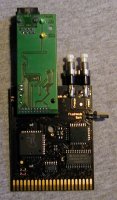 http://www.dunkels.com/adam/tfe/
http://www.dunkels.com/adam/tfe/
Components:
- Final Ethernet Adapter or
In early 2000 an embedded Ethernet controller chip made it possible for the 64 and other 8-bit computers to archive connection on the Ethernet.
The CS8900a Ethernet chip is at the heart of the Final Ethernet. To make use of the controller the Contiki operating system was created capable of running a browser on an unexpanded 64.
Contiki has added a few key features to make file transfer easier over a network or the Internet, mainly the ability to download .d64 disk image files onto Commodore 1541 disks or upload disk into .d64 images.
Since the Creation of TFE there have been a few other projects based on the technology including the Retro-Replay Ethernet daughter board for the Retro Replay Cartridge from Individual Computing in Germany.
There is also the HyperLink web Browser which uses the Lantronix UDS-10 Serial-Ethernet adapter.
HIGH SPEED RS-232
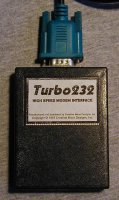 http://store.cmdrkey.com/agora.cgi?cart_id=6525613.1014*pP0WI6&p_id=00301&xm=on&ppinc=search3
http://store.cmdrkey.com/agora.cgi?cart_id=6525613.1014*pP0WI6&p_id=00301&xm=on&ppinc=search3
Components:
- Retro Replay Cartridge & Silver Surfer Adapter or
- CMD Swiftlink Cartridge or
- CMD Turbo-232 Cartridge; and null modem cable
Back in the Commodore BBS heydey Creative Micro Designs created two high speed adapters the Swiftlink and later the Turbo 232. Both interfaces plug into the cartridge expansion port and can archive speeds up to 230kbps (which then is limited more by the 8-bits' CPU).
This may make transfers a bit more complex but much faster than traditional serial connection.
Also in production is the Silver Surfer high speed adapter, this one is a daughterboard that plugs into the Retro Replay programmable utility cartridge. (and is also compatible with the Amiga 1200's clock port)
You can get on the internet with the Turbo 232 with the use of the HyperLink web Browser and the Lantronix UDS-10 Serial-Ethernet adapter.
SIPOD IEEE-488 / 64
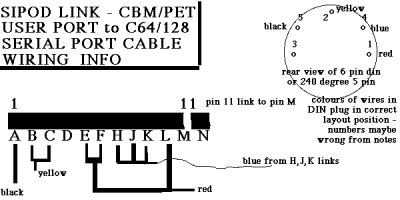 http://members.tripod.com/~petlibrary/SPDCBL.HTM
http://members.tripod.com/~petlibrary/SPDCBL.HTM
Components:
- 6-PIN DIN Connector
- 4 conductor shielded cable
- 12/24 Edgeboard Connector witrh .156” contact spacing
If you happen to have a 64 and a PET laying about the SIPOD is another alternative to get data from the IEEE-488 only drives like the 8050 and 8250, the program is similar to C2N232's cbmlink or 64HDD where the PET becomes the 'server' in control by the 64.
The interface connects the PET's parallel port into the Commodore 64's IEC serial bus, the software translates the 64's IEC serial commands and relays them to devices in it's IEEE-488 bus. Since all the management software is on the PET side, the 64 operator can choose any non-drive specific file/disk utilities to get the data transfered.
It would be theoretically possible to adapt the SIPOD to connect to the PC using a cross SIPOD-X1541 cable and get some of the benefits of the C2N232 without the complex hardware (or speed).
THE RELIABLE (and almost universal) Commodore Datasette
- Cassette Tapes
- PC Sound Card
- Commodore Datasette Drive
Since so many of the Commodore 8-bits share the cassette port it has been a great (albeit slow) way of getting programs and data between platforms (such as from the PET to the 64 and then from the 64 there re far more ways of getting it to a PC.)
The computers that do not have a Cassette port are the B128 (actually they do have the port, but not the ROM software to load or save programs) and the SX64. Commodore broke with their cassette standard on the Plus/4 and C-16 which do have technically the same electronics (and can be used with an adapter) but record their data with enough difference you cant use their tapes on other Commodores and visa-versa (this has been taken into account for the C2N232 adapter to work though).
There are a some PC interfaces and programs specifically designed to read and write directly to Commodore format tapes using a standard cassette recorder and the PC's sound card. They record the tapes by imitating the commodore tape sounds and read them by analyzing the playback into the microphone of the sound card. There is also at least one interface to connect a Commodore datasette directly to a PC for tape transfer.

